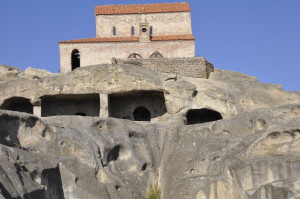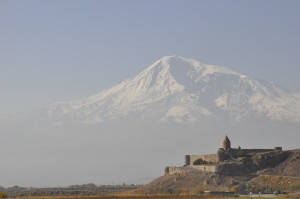North of Turkey, south of Russia, and bordering the Caspian sea,three countries lie steeped in ancient cultural and religious history, each with its own unique and entirely separate identity. Still evolving in the post-Soviet era, they are neighbors who share borders, still reveling in their relatively new independence, and increasingly developing markets to attract more tourists.
With some of the more jaw-dropping vistas to be found anywhere in the world, it’s impossible to pinpoint any one area photographers and tourists will scramble to see; there are seventh-century monasteries atop cliffs accessible only by four-wheel vehicles, a church with its entrance perched so high above ground level that you have to crawl up its steps on your hands and knees (getting back down the same way), and many other natural and man-made wonders of the earth.
By the end of 2012, more than four million tourists visited Georgia, and more are expected in 2014. Tibilisi, its capital, is a beautiful and sophisticated city, divided into two banks by the Kura River and particularly spectacular at night. The river’s romantic promenades and twinkling lights may be somewhat reminiscent of Paris—high praise indeed—but Tibilisi’s ambiance, architecture and twisting streets have a character all their own. Surrounded by high bluffs, Tibilisi is ablaze after dark, its castles, churches, and other historic structures perched above it, most of them illuminated in orange and gold tones. But it isn’t just the river that gives Tibilisi its nightly golden glow; there’s also the spectacular Bridge of Peace, a contemporary, bow-shaped footbridge built in 2010. When darkness falls, the bridge’s metal and glass structure is illuminated in an ever-changing array of colors.
Fine dining establishments abound in Tibilisi, many of which are to be found in the old city, with ancient stone staircases leading from one street to another. Understandably, many of the city’s restaurants sit high above the river, offering expansive views, elegant meals, and the occasional traditional Georgian song performed by local singers. There are also hotels for every budget, ranging from modestly priced establishments to gleaming skyscrapers such as the Holiday Inn or the Radisson Blu Iveria, both of which offer spectacular views of the city.
Visitors to Georgia will find that there’s far more to see and experience than just its capital. Drives throughout the Georgian countryside offer some breathtaking journeys back through time. In the ancient, 3,000-year-old city of Mtskheta, for example, the sixth-century Jvari Monastery (“monastery of the cross,” and a UNESCO World Heritage Site), sits on a high cliff overlooking the city, and the utterly spectacular Svetitskhoveli Cathedral, an enormous eleventh-century structure, contains the Robe of Christ. It is yet another UNESCO World Heritage Site.
A wonder of nature, culture, religion and technical wizardry can be found in the town of Uplistsikhe (meaning “the Lord’s prayer), a complex reached by several series of stairways leading to a cluster of cave dwellings that once contained bakeries, an amphitheater, and a wine cellar, all sitting beneath a starkly simple three-nave basilica dating back to the ninth century.
For those who love wine, a little known fact: Georgia is the oldest wine-producing country in the world, dating back 8,000 years. Its white wines—difficult to find in the U.
S.—are of the highest quality and made entirely differently from the methods known elsewhere through the world.
A drive up the Georgian Military Highway, leading to the Georgian-Russian border, leads to the beautiful seventeenth-century Ananuri architectural complex, consisting of two churches and a fortress overlooking the town of Zhinvali.
More inaccessibly, and requiring the use of a four-wheel vehicle on rocky roads that occasionally turn into non-roads altogether, is a trip to the fourteenth-century Gergeti Trinity Church, situated at a height of more than 7,000 feet. This stunning structure consists of a church and separate bell tower and is situated against the backdrop of Mt.
Kazbegi, one the highest glaciers in the Caucasus. Its isolated location and vast connection to the wonders of nature make it a popular destination for mountain climbers, who frequently spend about three hours to make the trek up to the church.
In Armenia, tourism has been a key sector to the economy, with 500,000 tourists visiting the country each year. Travelers with a love of nature, a sense of adventure and a curiosity about religious history will find much to love in Armenia. Although many of its visitors are European, the country’s wish to draw more American visitors to their country is palpable at every turn. Major investments in hotels have taken place in recent years, with attractions such as Lake Sevan—the world’s largest mountain lake—proving especially popular for tourists and locals alike. Mount Ararat—the traditional site of the landing of Noah’s Ark—is yet another huge draw.
One of the first notable sights in Armenia is the tenth-century Akhtala ruins, with its church among the best preserved in Armenia. Inside, beautiful and amazingly intact frescoes decorate the walls, many in rich shades of red and blue—providing some of the finest examples of Byzantine art outside the traditional borders of Byzantine itself.
Located in the Lori area of Armenia is another of Armenia’s picture-perfect structures, the medieval Haghpat Monastery, overlooking the Debed River. It was included in UNESCO Heritage’s List in 1996 and is considered a masterpiece of religious architecture.
The first overnight stop in Armenia took place in the spa town of Dilijan. Set against a background of thick pine forests, the relatively isolated Hotel Dilijan Resort and Spa is an ideal choice for those in pursuit of clean air, beautiful vistas, and long walks in a completely rural atmosphere.
Another architectural marvel, The Garni Pagan Temple (another UNESCO site), is a destination in Armenia that any visitor would be foolish to miss. The temple dates back to the first century A.D. and is remarkably intact.
Another of Armenia’s magnificent historic and religious “photo-ops” is the Geghard Monastery. The main chapel was built in 1215, while the monastery complex dates to the fourth century. The complex is architecturally notable in a number of ways, not the least of which is that portions of it have been carved out of the mountain adjacent to it.
Several nights in Yerevan, Armenia’s lively and bustling capital, were spent at Yerevan’s first and finest hotel, the elegant 1926 Golden Tulip, a masterpiece of deco design, whose central location is only a short walk to Republic Square and the opera house.
Perhaps one of the most spectacular sights in all of Armenia is to be found at the Khor Vap Monastery, sitting against the backdrop of Mt. Ararat.
Crossing the border to Azerbaijan, one of the first impressions on American tourists is the country’s famous variety of colorful carpets, considered by many to be the world’s finest. They are found in shops, draped over railings, and hanging from bridges, to say nothing of the countless tourist shops that beckon visitors into their frequently tiny rooms with layer upon layer of hand-made carpets that invite customers to ship or carry them home.
A visit to Gobustan National Park, another UNESCO World Heritage Site, has been declared a national historical landmark for the quality and density of its rock art engravings and 6,000-year-old secret carvings dating back between 5,000-40,000 years.
On arrival in Baku, the capital of Azerbaijan, visitors may experience something of a shock: nearly 6,000 miles from New York, deep into a world few tourists have ventured, lies a gorgeous, cosmopolitan city, a major financial hub, and a home to many of the world’s most elegant shops. Somewhat unexpectedly, Baku rivals any of the most romantic, sophisticated and beautiful cities in the world, including Paris, Venice, and Florence. Built by oil barons in the late nineteenth and early twentieth centuries, the architecturally ornate buildings that line Baku’s gracefully winding streets are a marvel to behold. Bordering the Caspian Sea—famous, of course, for its caviar production—Baku is strongly reminiscent of the cities lining the French Riviera. Its stunning location is an appealing destination for American tourists in search of someplace new. They will not be disappointed.
Like Georgia and Armenia, Azerbaijan, too, has its share of historic and religious places to visit—the fortress in Baku’s Old Town, with access frequently restricted to pedestrians; the Maiden’s Tower—the symbol of the city—built in the twelfth century; and the Palace of the Shirvanshahs (also known as the Fire-Worshipers’ Temple, dating to the fifteenth century). In the countryside outside Baku is a totally unique sight: Yanar Dag (“burning mountain”), a natural gas fire on a hillside that literally seeps from the earth and has been burning without stop for more than 2,000 years. It’s an experience no visitor will want to miss.
Georgia, Armenia and Azerbaijan are three destinations little known to many American travel agents. There’s real magic to be found here, hidden to the world in so many ways until a mere 23 years ago, when travel to the former Soviet Union rarely included visits to these three fascinating, beautiful and historic countries. Much has changed since their independence, and it’s progressively clearer that with rapid developments in the hotel industry, and with ever-larger upswings in the number of visitors each year, the three countries are now ascending to the ranks of major destinations for individuals and groups alike.
This article would not have been possible without the invaluable organization and hospitality of Flo Tours USA, under the expert guidance of owner Cengiz Aras. With knowledgeable guides in each country, excellent accommodations, and great attention to detail, it is a superb way to explore this distant area of the world.
How to get there: Turkish Airlines has flights from New York to Istanbul, with a connecting flight to Baku.
Flo Tours USA, www.flotours.com



